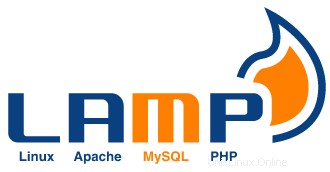
In questo tutorial, ti mostreremo come installare LAMP Stack su CentOS 6. Per chi non lo sapesse, LAMP rappresenta uno stack completo contenente il server web più popolare noto come Apache, il server di database più popolare MySQL e il più popolare linguaggio di programmazione Web open source noto come PHP. Tutti i componenti sono software gratuiti e open source e la combinazione è adatta per la creazione di pagine Web dinamiche.
Questo articolo presuppone che tu abbia almeno una conoscenza di base di Linux, sappia come usare la shell e, soprattutto, che ospiti il tuo sito sul tuo VPS. L'installazione è abbastanza semplice. Lo farò mostra l'installazione passo passo di LAMP (Linux Apache, MySQL e PHP) sul server CentOS 6.
Prerequisiti
- Un server che esegue uno dei seguenti sistemi operativi:CentOS 6.
- Si consiglia di utilizzare una nuova installazione del sistema operativo per prevenire potenziali problemi.
- Accesso SSH al server (o semplicemente apri Terminal se sei su un desktop).
- Un
non-root sudo usero accedere all'root user. Ti consigliamo di agire comenon-root sudo user, tuttavia, poiché puoi danneggiare il tuo sistema se non stai attento quando agisci come root.
Installa LAMP Stack su CentOS 6
Passaggio 1. Prima di tutto, assicurati che tutti i pacchetti siano aggiornati.
yum -y update
Passaggio 2. Installazione di Apache su CentOS 6.
Installeremo Apache con yum, che è il gestore di pacchetti predefinito per CentOS 6:
yum install httpd
Avvia Apache e aggiungilo per avviarlo automaticamente all'avvio del tuo sistema usando:
chkconfig --levels 235 httpd on service httpd start
Puoi verificare che Apache sia realmente in esecuzione aprendo il tuo browser web preferito e inserendo l'URL http://your-server's-ip-address e devi aprire la porta 80 per rendere accessibile il tuo server web:
/sbin/iptables -I INPUT -p tcp --dport 80 -j ACCEPT /etc/rc.d/init.d/iptables save
Passaggio 3. Installazione di MySQL su CentOS 6.
Installa MySQL con il seguente comando per iniziare l'installazione:
yum install mysql-server
Dopodiché aggiungilo all'avvio del tuo sistema e avvia il server MySQL usando i seguenti comandi:
chkconfig --levels 235 mysqld on service mysqld start
Per impostazione predefinita, MySQL non è protetto. Puoi proteggere MySQL utilizzando mysql_secure_installation sceneggiatura. dovresti leggere attentamente e sotto ogni passaggio che imposterà una password di root, rimuoverà gli utenti anonimi, non consentirà l'accesso root remoto e rimuoverà il database di test e l'accesso per proteggere MySQL:
mysql_secure_installation
Per accedere a MySQL, usa il comando seguente (nota che è lo stesso comando che useresti per accedere a un database MySQL):
mysql -u root -p
Passaggio 4. Installazione di PHP su CentOS 6.
Infine, esegui i comandi seguenti per installare PHP insieme ad altri moduli utili:
yum install php php-mysql
Puoi installare alcune altre estensioni PHP richieste dalle tue applicazioni. Di seguito è riportato un elenco dei moduli PHP disponibili:
php-bcmath => A module for PHP applications using the bcmath library php-cli => Command-line interface for PHP php-common => Common files for PHP php-dba => A database abstraction layer module for PHP applications php-devel => Files needed for building PHP extensions php-embedded => PHP library for embedding in applications php-enchant => Human Language and Character Encoding Support php-gd => A module for PHP applications using the gd graphics library php-imap => A module for PHP applications that use IMAP php-intl => Internationalization extension for PHP applications php-ldap => A module for PHP applications that use LDAP php-mbstring => A module for PHP applications which need multi-byte string handling php-mysql => A module for PHP applications that use MySQL databases php-odbc => A module for PHP applications that use ODBC databases php-pdo => A database access abstraction module for PHP applications php-pear.noarch => PHP Extension and Application Repository framework php-pecl-apc => APC cache optimizing PHP intermediate code php-pecl-memcache => Extension to work with the Memcached caching daemon php-pgsql => A PostgreSQL database module for PHP php-process => Modules for PHP scripts using system process interfaces php-pspell => A module for PHP applications using pspell interfaces php-recode => A module for PHP applications using the recode library php-snmp => A module for PHP applications that query SNMP-managed devices php-soap => A module for PHP applications that use the SOAP protocol php-tidy => Standard PHP module provides tidy library support php-xml => A module for PHP applications which use XML php-xmlrpc => A module for PHP applications which use the XML-RPC protocol php-zts => Thread-safe PHP interpreter for use with the Apache HTTP Server
Riavvia apache in modo che tutte le modifiche abbiano effetto:
service httpd restart
Per testare PHP, crea un file di prova chiamato info.php con il contenuto seguente. Salva il file, quindi cercalo per vedere se PHP funziona:
nano /var/www/html/info.php
<?php phpinfo(); ?>
Congratulazioni! Hai installato con successo LAMP. Grazie per aver utilizzato questo tutorial per l'installazione di LAMP (Linux Apache, MySQL e PHP) sul sistema CentOS 6. Per ulteriore aiuto o informazioni utili, ti consigliamo di per controllare il sito Web ufficiale di Apache, MySQL e PHP.